Submitted by: Greg Hunolt
June 8th, 2009
The Klitzen Wireless Apparatus Company, and its post-World War I incarnation, the Klitzen Radio Manufacturing Company, originally of Racine, Wisconsin, with a later connection to Grand Rapids, Michigan, was one of the Midwest’s pioneer radio companies, with a history extending from 1913 and the spark era across the World War I divide into 1927.
Alan Douglas has told the story of Milhart F. Klipcera and his Klitzen company in his section “Klitzen / Michigan” in his Radio Manufacturers of the 1920’s, Volume II, page 167. In this article I will summarize and add to Alan’s narrative, and add detail on the Klitzen equipment and sets. I would be most happy to receive any corrections or additions that other collectors might care to provide, about either the history of the Klitzen company or about the wireless apparatus and radios it manufactured.
Douglas reports that Milhart Klipcera, who was licensed as an amateur station operator with the call sign 9CM, established the Klitzen Wireless Apparatus Company in Racine, Wisconsin. According to a Klitzen ad in Radio News, November 1922 (see figure 3), Klitzen started his company in 1913. Douglas notes that Klipcera apparently adopted the “Klitzen” name by playing off the trade name “Blitzen” that Clapp-Eastham had made well known for its wireless apparatus before World War I. (For example, in the October 1913 issue of Modern Electrics, Clapp-Eastham advertised a “Blitzen Receiving Set” (crystal) and a “Blitzen Transformer”.)
Before World War I, the Klitzen Wireless Apparatus Company, 1123 Herrick Avenue in Racine, advertised apparatus for radio amateurs in QST. In February, 1916 Klitzen offered a rotary spark gap motor and disk assembly (see figure 1). In December, 1916, and February, 1917, Klitzen offered the No. 202 Undamped Wave Coupler (tuned 2,000 to 18,000 meters) and No. 200 Load Coil (“suitable for use in Armstrong circuits”). Klitzen advertised parts in QST in March 1917.
When the United States entered World War I in 1917 the government put a war-time halt to all amateur radio activities. QST itself suspended publication from October, 1917 through May, 1919.
Douglas reports that Klitzen re-started as the Klitzen Radio Manufacturing Company in October 1919. In QST for November 1919, the Klitzen Radio Manufacturing Company, 1501 Flett Avenue in Racine advertised the Rotary Spark Gap. In the December, 1919 QST Klitzen advertised the No. 102 Undamped Wave Coupler, which looked very much like, and probably was, the earlier No. 202, to “copy signals from high power Arc sets” (see figure 2).
The December, 1919 ad also announced the availability of Catalog C. This catalog offered a wide range of apparatus, and in particular included the No. 225 Regenerative Receiving Set, a tuner with a range of 150 to 800 meters. It was intended to be used with the No. 250 Audion Panel, configured as a detector and using a Marconi VT tube, and with a headset (Klitzen offered Baldwin and Murdock headsets in Catalog C).
Klitzen advertised the No. 225 Regenerative Receiving Set tuner in 1920, e.g. in Radio Amateur News (i.e. Radio News) in April, 1920, in an ad also featuring the No. 125 Rotary Spark Gap.
Douglas notes that in November, 1921, both the Barawik Company (Chicago) and Montgomery Ward advertised the Klitzen regenerative tuner and detector-amplifier, and Montgomery Ward offered them in its 1922 catalog. These must have also been the No. 225 Regenerative Tuner mentioned above and its successor and the No. 125 Detector & Amplifier to be discussed below.
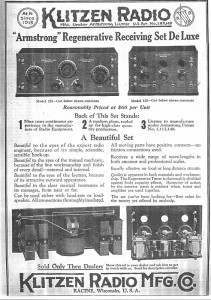 Fig 3 – Radio News, November 1922.
Fig 3 – Radio News, November 1922.
In Radio News, November 1922, Klitzen advertised the “Armstrong” Regenerative Receiving Set Deluxe, comprised of the No. 225 Regenerative Tuner and the new companion No. 125 Detector & Amplifier (see figure 3). The new 1922 version of the No. 225 Regenerative Tuner can be distinguished by its two tap switches, rather than the single tap switch on the 1919 version. The No. 125 Detector & Amplifier was a three tube unit, a detector and two audio frequency (AF) amplifier stages, intended to drive a speaker as well a headset. The ad stated that the set was manufactured under the Armstrong regenerative circuit license, which Klitzen had purchased from Westinghouse.
In December, 1922, the Radio News Klitzen ad, in addition to the No. 225 tuner and No. 125 Detector & Amplifier, also mentioned two new units. The first was a No. 300 receiver that was a No. 225 tuner with a detector added, able to drive a headset. The second unit was a No. 150 three step amplifier intended for use with the No. 300 receiver. The combination “makes a set that reaches from coast to coast and can be used with a loud speaker”.
Klitzen was listed in the Radio Merchandising Buyers’ Guide, September 1922, the Radio Red Book, November 1922, and the Radio Dealer Year-Book 1923-1924 at a Racine address of 4th and Lake Streets.
The November and December 1922 Klitzen ads are the last I have found for Klitzen in Racine. There was at least one additional set manufactured by Klitzen, probably in 1922 or 1923, the Model 525 Regenerative Amplifying Receiver, a photo of which appeared in Antique Radio Classified (ARC) in February, 2005. The set included a regenerative tuner, detector, and two AF amplifier stages. The late Dick Bury’s magnificent collection included a Model 525 with a different panel configuration in that it lacked a tap switch present on the set that appeared in ARC (see figure 4).
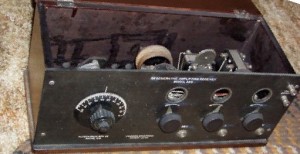 Fig 4 – Klitzen 525, courtesy of Dale Boyce
Fig 4 – Klitzen 525, courtesy of Dale Boyce
Klitzen manufactured radios for at least two other companies (besides its involvement with the Michigan Radio Corporation to be discussed below). One company was the Mitchell Blair Company of Chicago, Illinois. Dick Bury’s collection included a pair of units, a “Blairco Junior Model” Type T-1 one tube regenerative receiver and Type A-1 two stage AF amplifier. Both units bear identification tags including “Mfg. by Klitzen Radio Mfg. Co.” and that the sets were licensed under the Armstrong patent, which would apply to the T-1 regenerative receiver. See Figure 5.
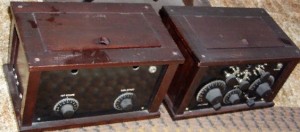 Fig 5 – Blairco T1 and A1, Dale Boyce
Fig 5 – Blairco T1 and A1, Dale Boyce
The second company was Paramount Radio Corporation of St. Louis, Missouri. The December, 1985 issue of ARC, page 9, includes a photograph of two Paramount units, a one tube “Junior” regenerative receiver and a matching two tube AF amplifier. The units have Paramount nameplates and interior decals indicating their manufacture by Klitzen under the Armstrong patent. A distinctive feature of the receiver was spring loaded verniers on the tuning and tickler dials. They would have been manufactured about 1922. A photo of a similar unit appeared in the August, 2008 issue of ARC. It is a three tube regenerative receiver with a detector and two AF amplifier stages. It is in the same style as the two Paramount units mentioned above, with the same Paramount nameplate and Klitzen decal. The receiver also features the same spring loaded verniers on the tuning and tickler dials. Paramount also sold a version of the Klitzen Model 525 Regenerative Amplifying Receiver; Dick Bury’s collection included one of these sets, identical to the native Klitzen 525 except for having a red-orange front panel with a Paramount engraved logo instead of the black front panel on the native Klitzen set.
Klitzen apparently also manufactured sets for the Globe Electric Company of Milwaukee, Wisconsin. For example, the 1922 Globe 607 receiver-amplifier has a metal tag identifying Klitzen as manufacturer on the inside of its cabinet lid.
The next Klitzen sets I have information about are the S. F-16 Receiver and S. F-17 Two-Stage Amplifier, for which I have a copy of an undated instruction sheet produced by Klitzen bearing an address of Grand Rapids, Michigan. The S. F-16 Receiver is a one tube regenerative receiver manufactured under the Armstrong patent. The layout of the front panel is distinctive; left and right dials, the left one a tickler control labeled “Intensifier”, and the right dial for tuning. Between these are an upper center antenna switch, and a lower rheostat. See Figures 6 and 7. Examples of these receivers indicate that they were also sold through outlets in Chicago and by the W. F. Main Radiophone Co. of Cedar Rapids, Iowa as the “Splendid Deluxe Radio Receiver Model A” (courtesy of Glenn Trischan).
This Grand Rapids address on the instruction sheet suggests that Klitzen had moved from Racine, Wisconsin, to Grand Rapids by the time these sets were produced. Alternatively, it may mean that Klitzen’s front office for sales was now in Grand Rapids, but the company’s manufacturing may have still been based in Racine. The instruction sheet is undated, but my guess would be 1923.
I have in my own collection two examples of the S. F-16 Receiver, both of which have inside nameplates for Klitzen in Racine, Wisconsin. They are serial numbers 1,053 and 15,893.This suggests that either they were made before Klitzen moved to Grand Rapids, or that Klitzen continued to manufacture these sets in Racine after its sales outlet was shifted to Grand Rapids. This provides a convenient segue into the Michigan Radio Corporation part of the story.
Douglas notes that the Michigan Radio Corporation (MRC) of Grand Rapids, Michigan, began advertising in November, 1922. I have a copy of a MRC ad from a late 1922 issue of Electrical Record which features the Michigan “Senior” Receiver, a three tube regenerative receiver with a detector and two AF amplifier stages. This set very closely resembles the Paramount three tube receiver whose photo appeared in the August 8, 2008 issue of ARC, suggesting that the Michigan “Senior” might have been manufactured by Klitzen for MRC. The same set was advertised in Wireless Age in December 1922, and in Radio News in January, 1923. The January ad, unlike earlier ads, calls the Michigan “Senior” (now also referred to as the MRC-7) a regenerative set, and states that it is manufactured under the Armstrong patent. These ads also featured the smaller Michigan “Junior” set, a one tube set which was advertised as not regenerative, and noted the availability of a Michigan Two Stage Amplifier that could be use with it. The “Junior” receiver is very similar to the Paramount “Junior” one tube set which appeared in ARC in December, 1985, again suggesting that Klitzen manufactured these sets for both Paramount and MRC. See Figure 8 for a later (Radio News, May 1923) example of an ad for these sets.
In his narrative, Douglas notes that Klitzen granted MRC a sub-license which would allow MRC to sell regenerative sets under the Armstrong patent. This apparently occurred in November or December 1922, too late for mention in December ads, but in time for January and later ads (e.g., see figure 8). The latest ad I have for the Michigan “Senior” and “Junior” sets is in Radio News in July, 1923.
Douglas reports that Westinghouse, who now held the Armstrong patent, sued Klitzen in August, 1923, charging breach of license and asking the court to prohibit Klitzen from sublicensing in violation of the terms of its license agreement. Klitzen cancelled the sublicense to MRC, leaving MRC in legal jeopardy. Douglas says that by March, 1924, MRC had resolved its legal problems with Westinghouse and began selling Klitzen-made receivers.
In September 1923, MRC advertised a new receiver (“our latest triumph”) in Radio News and Radio Broadcast, the Michigan “Midget”. The Midget is not advertised as regenerative. The ads note the availability of a matching two stage AF amplifier. The “Midget” is marked by a sloped metal front panel featuring the same layout as the Klitzen S. F-16 receiver discussed above, but with distinctive lever handles on all four controls. I have two examples of the “Midget” in my collection, serial numbers 10,486 and 14,265, which are almost identical regenerative sets (see figures 9 and 10). The presumably later serial number 14,265 set has a metal tag inside the front panel indicating that the set was manufactured by Klitzen in Racine, Wisconsin, under the Armstrong patent. MRC advertised the set in January and February, 1924 (Radio and Radio News, see figure 11), now as the M-10 “Midget Detector” accompanied by the M-11 “Midget Amplifier” or, for both units on one case, the M-12 “Midget Detector and Amplifier”. In June, 1924, MRC (now showing an address of 33 Ottawa Street in Grand Rapids) advertised the Midget in Radio News as the M.R.C. 10 “Michigan One Tube Receiving Set”, noting the availability of the companion M.R.C. 11 amplifier. This ad, for the first time, cites the Armstrong patent. This version of the Midget is pictured with a small Michigan nameplate on the front panel beneath the rheostat, replacing a stenciled name on the earlier Midget. My two Midgets both have such nameplates, perhaps dating them to 1924. The metal “manufactured in Racine” tag on the later one suggests Klitzen was still manufacturing in Racine then; also note the apparently later serial number on one of my S. F-16’s that also bears a “manufactured in Racine” tag.
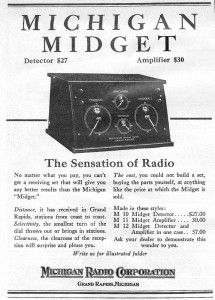 Fig 11 – Radio News, January 1924
Fig 11 – Radio News, January 1924
In July, 1924, MRC announced the “Michigan Four Tube Set” model MRC 4, that was an expanded Midget including an RF stage in front of the detector and two AF stages. The ad notes that the set is “non-radiating”, possibly a tuned RF stage without regeneration (the Armstrong patent is not cited). The large table model set is packaged with a speaker and battery compartment and a fold down front door. In October, November, and December, 1924 (see figure 12) and January, 1925 MRC ads in Radio News, Radio Broadcast, and Popular Radio recapped the MRC line-up. The Midget was now the MRC 2, which appears identical to earlier Midgets but is a two tube regenerative set, adding an AF stage. The MRC 11 is the two stage amplifier, and the MRC 12 the combination of the Midget and the MRC 11 in one case. (I have in my own collection an MRC 12, Klitzen serial numbers 3768 on the receiver, 3767 on the amplifier, and MRC serial numbers 24996 and 17979.) The MRC-3 was a three tube receiver, apparently a detector and two AF stages, in a large cabinet with left and right side panels. At the top of the line was the MRC 4 Four Tube Set (three AF stages). These ads all cited a new Pearl Street address for MRC in Grand Rapids. The MRC 3 and MRC 4 sets were listed in the June 1925 Radio Industry ‘Encyclopedia of Radio Receiving Sets’ (the MRC 3 was incorrectly described as a four tube TRF set).
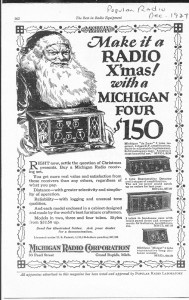 Figure 12 – Popular Radio, December 1924
Figure 12 – Popular Radio, December 1924
Douglas notes that MRC last advertised in January 1925, and I have not seen later ads for MRC. He reports that Klitzen returned in April 1925 with a Grand Rapids address, advertising two inexpensive models, the Kent and Wolverine. I have a November, 1925 ad from Radio Industry for the Klitzen Wolverine receiver (see figure 13). The set, in a fancy mahogany cabinet, said to reflect “Grand Rapids workmanship”, was a three tube regenerative set with a front panel very like the Midget’s, down to its distinctive lever style handles on its four controls. One could easily imagine the radio chasses being produced in Racine, and the cabinets being made and final assembly occurring in Grand Rapids. The Grand Rapids, Michigan address cited in the ad was 21-31 Ottawa Street, very close to an earlier MRC address. Klitzen was listed in the August 1925 McGraw-Hill Trade Directory, with an address of 21 Ottawa Street in Grand Rapids. The Wolverine and Kent sets were listed in the November 1925 Radio News Set Directory and the Radio Industry Encyclopedias of Radio Receiving Sets for November, 1925 and March, 1926, with a Grand Rapids address for Klitzen.
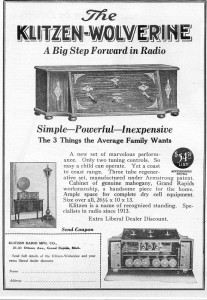 Fig 13 – Radio Industry, November 1925
Fig 13 – Radio Industry, November 1925
Finally, Douglas concludes his narrative by noting that Klitzen went into receivership in 1926 and was dissolved in January, 1927.
Looking back over the Klitzen / MRC products, one can see after an innovative early period during which Klitzen produced a variety of apparatus, that especially from 1923 on the company narrowed its focus to one basic design with variations, a regenerative tuner-detector with different numbers of AF stages (zero to three). This design became obsolete in the mid-1920’s. The company advertised nationally and enjoyed some success until the world moved on (especially in the modest price range of the Klitzen / MRC sets) to TRF sets and their neutrodyne variations, and ultimately superheterodynes. The company didn’t move with the world and disappeared. But it did leave behind a unique front panel design and those cool levers that I have a soft spot in my heart for.
If you have any information to correct or add to what I’ve presented above, or photos of Klitzen sets or wireless equipment you would be willing to share, I would very much appreciate hearing from you – Greg Hunolt, via email, or via postal mail: N5412 State Hwy 57, Plymouth WI 53073.
You can find more information about Klitzen sets – and indeed about battery sets in general – in the new 2009 edition of the Battery Set Compendium (BSC), which I am happy to make available to collectors, still free of charge. The BSC provides collectors with a ‘first stop’ source for information about early battery set radios and the companies that made them. As a ‘first stop’ source, the BSC contains as much information as is practical about the widest possible range of companies and radio types, and points to but does not duplicate sources of greater depth, such as the excellent Alan Douglas and Eric Wenass’ books, the articles published in Radio Age over the years, and in AWA publications. The scope of the BSC is early vacuum tube battery apparatus and complete sets from roughly 1909 through 1929 (excluding automobile and ‘farm’ radios). The BSC includes kits as well as factory assembled sets. The BSC includes early ‘modules’, apparatus such as detector units, amplifier units, tuner units, etc., that were connected together in various combinations to comprise complete sets, as well as sets themselves, providing a view of the evolution of the technology. The BSC now contains information (sometimes quite complete, sometimes sketchy) about 1,769 radio companies and 5,920 battery radios / apparatus. I owe a great debt of gratitude to Merrill Bancroft, E. H. Scott historian Kent King, Dale Boyce, Charles Kirsten, Gary Alley and others for generously contributing or giving me access to information I’ve added to the 2009 BSC.
Figure 1 – Klitzen ad, QST, February 1916.
Figure 2 – Klitzen ad, QST, December 1919, p56.
Figure 3 – Klitzen ad, Radio News, November 1922, p895.
Figure 4 – Model 525 (Black) (Courtesy of Dale Boyce)
Figure 5 – Mitchell Blair T-1 and A-1 (Courtesy of Dale Boyce)
Figure 6 – Klitzen S.F-16 Front View (Author’s collection)
Figure 7 – S.F-16 Top View (Author’s collection)
Figure 8 – MRC ad, Radio News, May 1923, p2047.
Figure 9 – Klitzen Midget, front view (Author’s collection)
Figure 10 – Klitzen Midget, top view (Author’s collection)
Figure 11 – MRC ad, Radio, January 1924, p93.
Figure 12 – MRC ad, Popular Radio, December 1924, p162.
Figure 13 – Klitzen ad, Radio Industry, November 1925, p64.
References
Douglas, Alan, “Radio Manufacturers of the 1920’s”, Sonoran, 1989, Volume II, p167.
Klitzen Radio Manufacturing Co., Catalog C, December 1919.
Antique Radio Classified: December 1985, p9; October 1998, p22; February 2005, p14; March 2007, p20; August 2008, p21.
Electrical Record, MRC ad: December 1922.
Modern Electrics, Clapp-Eastham ad: October 1913, p661.
Popular Radio, MRC ads: October 1924, p23; December 1924, p162; January 1925, p51.
QST, Klitzen ads: February 1916; December 1916; February 1917; March 1917; November
1919, p56; December 1919, p56; March 1920, p56.
Radio, MRC ad: January 1924, p93.
Radio Broadcast, MRC ads: March 1923, April 1923, September 1923, July 1924, November 1924, p124.
Radio Dealer Yearbook 1923-1924, p144.
Radio Industry, Klitzen (Grand Rapids) ad: November 1925.
Radio Industry, Encyclopedia of Radio Receiving Sets, June 1925, p46.
Radio Industry, Encyclopedia of Radio Receiving Sets, November 1925, p40.
Radio Industry, Encyclopedia of Radio Receiving Sets, March 1926, p35.
Radio Merchandising Buyers’ Guide, September 1922, p311.
Radio News, Klitzen ads: April 1920, p573; November 1922, p895; December 1922, p1121; Radio News, MRC ads: January 1923, p1423; May 1923, p2047; July 1923, p99; September
1923, p346; February 1924, p1185; June 1924, p1859; July 1924, p135; November 1924, p859.
Radio News Set Directory, November 1925, p64.
Radio Red Book, November 1922, p78.
Radio Trade Directory, McGraw-Hill, August 1925, p130.
Wireless Age, MRC ad: December 1922, p108.

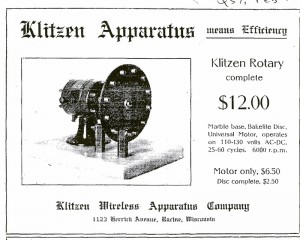
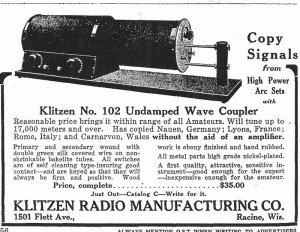
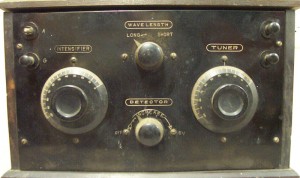
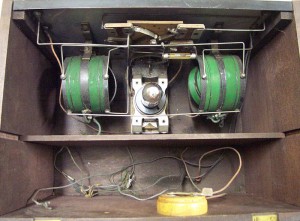
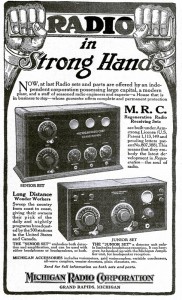
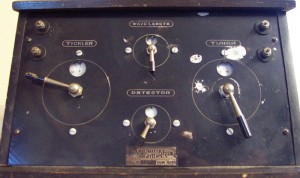
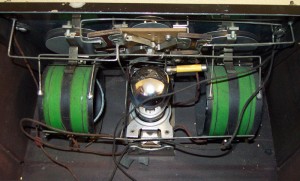
Very nice article! I recently acquired a Michigan Radio M-10 Midget. It was in really bad shape, but slowly getting to look almost like new! This is my first radio restoration, but I hope to get it working soon! I’d be happy to send pictures, but I didn’t see an email address for the author.